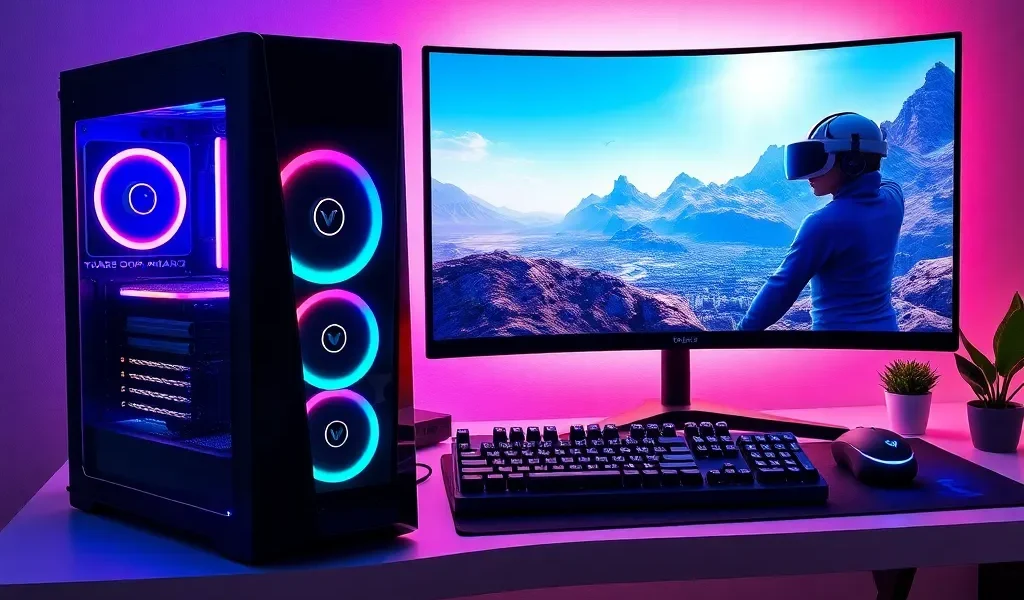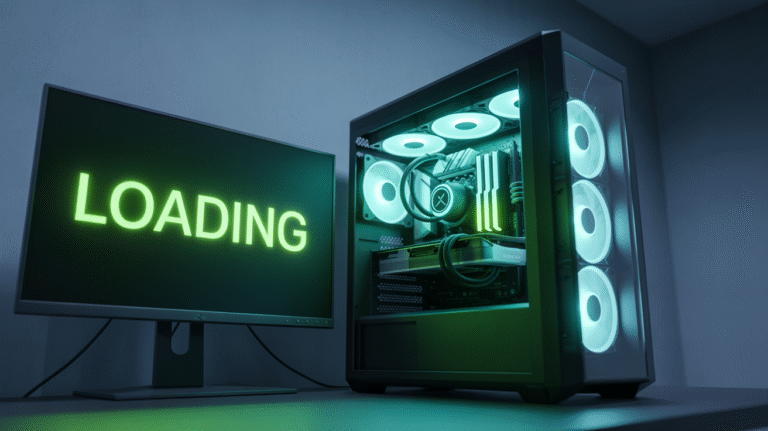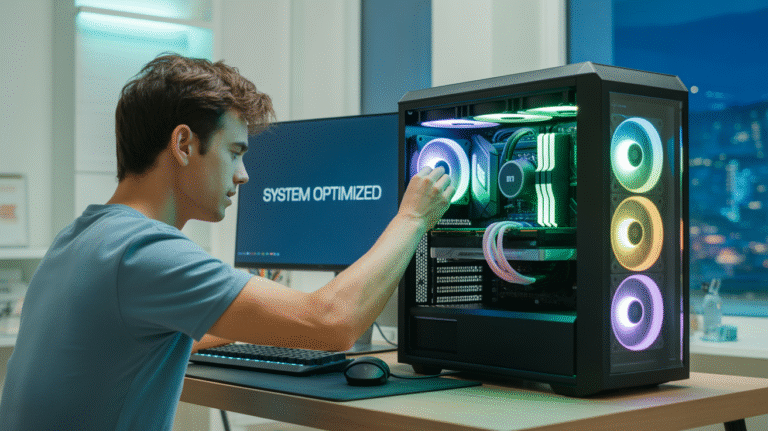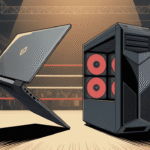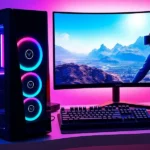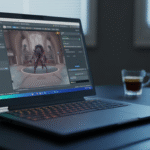Diving into the World of VR Gaming
Virtual Reality (VR) is no longer a futuristic concept; it’s here, transforming how we play games. Stepping into VR offers unparalleled immersion, transporting you directly into vibrant game worlds. However, achieving this level of presence requires significant computing power. Unlike traditional flat-screen gaming, VR demands high resolutions and extremely stable, high frame rates across two displays simultaneously to prevent motion sickness and deliver a smooth, believable experience.
To unlock the full potential of today’s best VR titles, from fast-paced action adventures to detailed simulations, you need a gaming desktop capable of handling the intense graphical and processing demands. A sub-par machine will result in choppy visuals, lag, and a broken sense of immersion. This guide will help you navigate the essential components and considerations for choosing a desktop that is truly VR-ready and capable of delivering breathtaking virtual worlds.
What Makes a PC “VR-Ready”?
The term “VR-Ready” isn’t just marketing jargon; it signifies that a computer meets specific performance thresholds set by VR headset manufacturers. These requirements, like those defined by Meta (formerly Oculus) for Rift/Quest Link or Valve for SteamVR, ensure that the PC can render virtual environments at a consistent frame rate and resolution sufficient for comfortable and immersive VR. Meeting these specifications minimizes issues like latency, stuttering, and visual artifacts that can ruin the VR experience and induce motion sickness.
Headset manufacturers typically provide both minimum and recommended specifications. While a PC meeting minimum specs might technically run VR, a system meeting or exceeding the recommended specs is crucial for a smooth, high-fidelity experience with graphical settings turned up. Focusing on recommended specifications is key to unlocking the “truly immersive” aspect of VR gaming.
Essential Components for VR Performance

A gaming desktop is a complex ecosystem of hardware working together, but some components play a more critical role than others when it comes to VR. These key parts must be powerful enough to handle the unique demands of virtual reality rendering and processing. Failing in one area can bottleneck the entire system, leading to a poor VR experience regardless of how powerful other components are.
Understanding the function of each essential component will empower you to make informed decisions when selecting or configuring your VR-ready machine. The synergy between these parts is what ultimately delivers the smooth, low-latency performance required for believable VR interaction.
Graphics Card (GPU): The VR Powerhouse
The Graphics Processing Unit (GPU) is arguably the single most important component for VR gaming. It’s responsible for rendering the complex 3D environments twice – once for each eye – at high resolutions and frame rates (often 90Hz or higher). A powerful GPU ensures crisp visuals, smooth motion, and the ability to enable advanced graphical features that enhance immersion.
Modern VR titles leverage technologies like high-resolution textures, complex lighting, and advanced physics, all heavily reliant on GPU performance. For VR, look towards recent generations of high-performance GPUs such as the NVIDIA GeForce RTX 30-series, 40-series, or equivalent AMD Radeon RX 6000 or 7000-series cards. Meeting at least the manufacturer’s recommended GPU is non-negotiable for a good VR experience.
Processor (CPU): Handling the Demands
While the GPU handles the heavy graphical lifting, the Central Processing Unit (CPU) plays a vital supporting role in VR. The CPU manages game logic, AI, physics calculations, input tracking from your headset and controllers, and communication between all hardware components. A weak CPU can bottleneck a powerful GPU, leading to performance dips and stuttering, especially in complex game scenes or applications with many interactive elements.
For VR, a modern multi-core processor is highly recommended. Look for Intel Core i5 (10th generation or newer) or i7/i9, or AMD Ryzen 5 (3000 series or newer) or Ryzen 7/9 processors. While not usually the primary bottleneck like the GPU, a capable CPU ensures the entire system runs smoothly and responsively, which is crucial for maintaining immersion in VR.
RAM (System Memory): Keeping Data Accessible
System Memory, or RAM, acts as your computer’s short-term memory, storing data the CPU needs quick access to. VR games, especially those with large environments or complex assets, can be memory-intensive. Having sufficient RAM ensures that the system can load assets quickly and run background processes without impacting game performance.
While 8GB might be the minimum for some basic VR tasks, 16GB of DDR4 or DDR5 RAM is the widely recommended standard for a smooth VR gaming experience today. This amount allows the operating system, the VR runtime software, the game itself, and any necessary background applications to run comfortably without excessive swapping to slower storage, which can cause noticeable stutters and loading delays.
Storage: Speed and Capacity
The type of storage drive in your desktop significantly impacts loading times for VR games. Waiting minutes for a game to load can break immersion before you even start playing. Traditional Hard Disk Drives (HDDs) are slow and not recommended for installing VR titles.
Solid State Drives (SSDs) offer drastically faster read and write speeds compared to HDDs, leading to much quicker game loading and level transitions. For the best performance, look for NVMe SSDs, which are significantly faster than standard SATA SSDs. Ensure you have enough storage capacity for the often large installation sizes of modern VR games and future titles.
VR Headset Compatibility
It’s essential to verify that the desktop you choose is compatible with your specific VR headset. While many high-end gaming PCs will work with most PC-tethered or PC-streamed headsets (like Valve Index, HTC Vive, PICO Neo, or Meta Quest via Link/Air Link), it’s always wise to check the headset manufacturer’s compatibility list or software requirements.
Connectivity is also key; ensure the desktop has the necessary ports, such as high-speed USB (USB 3.0 or higher) for tethering or DisplayPort/HDMI outputs compatible with your headset’s requirements. Wireless streaming solutions like Meta Air Link or Steam Link still rely on PC performance and a robust Wi-Fi network, but the PC’s hardware is the foundation.
Key Factors When Choosing a VR-Ready Desktop

Beyond the core components (GPU, CPU, RAM, Storage), several other factors influence the overall VR experience and the longevity of your investment. Prioritizing these aspects helps ensure smooth performance and provides room for future upgrades. Don’t just look at the headline specs; delve into the details.
Consider the cooling system, the power supply unit’s capacity, and the overall build quality. A well-designed system will run cooler and quieter under load, preventing thermal throttling that can degrade performance during extended VR sessions.
- Cooling Solution: VR gaming pushes components hard, generating heat. Effective cooling (either air or liquid) is vital to maintain peak performance and prevent thermal throttling. Look for systems with robust fans or liquid coolers, especially on high-end CPUs and GPUs.
- Power Supply Unit (PSU): The PSU provides power to all components. A sufficient wattage PSU with good efficiency and quality components is necessary to reliably power powerful VR-ready hardware, especially under heavy load. Check the recommended PSU wattage for the installed GPU.
- Upgradeability: Technology evolves rapidly. Choosing a desktop with standard components and adequate space/connections allows you to upgrade parts like RAM, storage, or even the GPU in the future, extending the life of your VR-ready machine.
Top 3 Picks: Recommended VR-Ready Gaming Desktops
Identifying the “best” desktop depends heavily on budget and specific needs, but here are examples of types of configurations you’ll find that offer excellent VR experiences across different tiers:
Entry-Level VR Performer
- Specs often include: NVIDIA GeForce RTX 3060/4060 or AMD Radeon RX 6700 XT/7700 XT, Intel Core i5 or AMD Ryzen 5 processor, 16GB DDR4 RAM, 1TB NVMe SSD.
- Target Performance: Capable of running most current VR titles comfortably at moderate settings and resolutions, perfect for getting started with immersive gaming.
Mid-Range VR Powerhouse
Specs often include: NVIDIA GeForce RTX 3070/4070 or AMD Radeon RX 6800 XT/7800 XT, Intel Core i7 or AMD Ryzen 7 processor, 16GB/32GB DDR4/DDR5 RAM, 1TB+ NVMe SSD.
Target Performance: Excellent performance for most VR games at high settings and resolutions, providing a substantial upgrade in visual fidelity and smoothness. Handles complex simulations and graphically demanding titles well.
High-End Enthusiast VR Rig
Specs often include: NVIDIA GeForce RTX 3080/3090/4080/4090 or AMD Radeon RX 6900 XT/7900 XT/7900 XTX, Intel Core i7/i9 or AMD Ryzen 7/9 processor, 32GB+ DDR5 RAM, 2TB+ NVMe SSD.
Target Performance: Delivers the absolute best VR experience possible with maximum settings, highest resolutions, and smooth performance even in the most demanding titles. Ideal for high-resolution headsets like the Valve Index or Pimax, or using features like supersampling for increased visual clarity.
Building vs. Buying a VR-Ready Desktop

When seeking a VR-ready machine, you have two primary paths: buying a pre-built desktop or building one yourself. Both have their advantages and disadvantages, and the best choice depends on your technical comfort level, time, and budget flexibility.
Building often provides more bang for your buck and allows for complete customization, but requires technical know-how and troubleshooting skills. Buying a pre-built system offers convenience, manufacturer warranty support, and saves time, though it can be slightly more expensive for equivalent hardware and offers less flexibility in component choice.
Optimizing Your Desktop for VR Performance

Once you have your VR-ready desktop, a few optimization steps can help ensure you’re getting the best possible performance and a consistently smooth experience. These tips focus on software settings and maintenance. Keeping your system running efficiently is just as important as the hardware itself.
Regular maintenance and proper software configuration can prevent performance bottlenecks and ensure compatibility with the latest VR titles and headset features. Don’t overlook these steps after setting up your new machine.
- Keep Drivers Updated: This is crucial, especially for your graphics card. NVIDIA, AMD, and Intel regularly release driver updates that include performance optimizations and bug fixes specifically for new game releases, including VR titles.
- Update VR Software/Runtime: Ensure your headset’s software (e.g., Oculus App, SteamVR) is always updated to the latest version. These updates often improve performance, add features, and enhance compatibility.
- Adjust In-Game and Headset Settings: Experiment with graphical settings within VR games and the headset’s software (like resolution, refresh rate, and supersampling). Find the balance between visual quality and performance that works best for your system and comfort level.
- Close Unnecessary Background Processes: Before launching a VR game, close any applications running in the background that consume significant CPU or RAM resources.
- Monitor Temperatures: Use monitoring software to keep an eye on your CPU and GPU temperatures during VR sessions. Overheating can cause performance throttling. Ensure your case has good airflow.
Future-Proofing Your VR Investment

The VR landscape is constantly evolving, with new headsets and more graphically intensive games on the horizon. While true “future-proofing” is challenging in technology, you can make choices today that position your system to handle future demands better. Investing slightly above the minimum recommended specifications is a smart strategy.
Choosing higher-end components now, particularly the GPU and CPU, provides more headroom for future software updates and more demanding VR experiences. Also, selecting a desktop with a quality motherboard and PSU that can support potential upgrades down the line offers flexibility. Aiming for recommended specs or higher is the best way to ensure your desktop remains a capable VR machine for years to come.
Conclusion: Stepping into Immersion
Embarking on your VR gaming journey requires more than just a headset; a powerful, VR-ready gaming desktop is the engine that drives truly immersive experiences. By focusing on key components like the GPU, CPU, and sufficient RAM, you lay the foundation for smooth, high-fidelity virtual worlds. Considering factors like storage speed, cooling, and headset compatibility further refines your choice.
Whether you opt for a carefully selected pre-built system or decide to build your own, investing in hardware that meets or exceeds recommended VR specifications is paramount. With the right machine, you’re not just playing a game; you’re stepping into another reality, ready to explore, interact, and experience gaming in a profoundly new and exciting way. Dive in, the future of gaming is immersive!
Glossary of VR/PC Terms
Thermal Throttling: When components overheat, they reduce performance to lower their temperature, leading to frame drops and stuttering.
FPS (Frames Per Second): The number of images your display shows each second. Higher FPS generally means smoother motion. In VR, a stable, high FPS (often 90+) is critical for comfort.
Latency: The delay between an action (like moving your head) and the visual response in the headset. High latency causes disorientation and motion sickness.
Resolution: The number of pixels displayed horizontally and vertically. Higher resolution means sharper images. VR headsets often have a per-eye resolution.
Refresh Rate (Hz): How many times per second the display updates the image. A higher refresh rate (e.g., 90Hz, 120Hz) reduces motion blur and flicker, contributing to a smoother VR experience.
GPU (Graphics Processing Unit): The primary component responsible for rendering images.
CPU (Central Processing Unit): The main processor that handles calculations, logic, and overall system tasks.
RAM (Random Access Memory): Temporary storage for data the CPU needs to access quickly.
SSD (Solid State Drive): A fast storage device using flash memory, significantly reducing loading times compared to HDDs.
NVMe (Non-Volatile Memory Express): A protocol and form factor for SSDs offering much higher speeds than SATA SSDs.
Supersampling: A rendering technique where the image is rendered at a higher resolution than the display and then scaled down, resulting in sharper visuals and reduced aliasing (jagged edges). Requires significant GPU power.
Frequently Asked Questions (FAQ)
Getting into VR gaming can bring up several questions about the necessary hardware. Here are some common queries prospective VR desktop owners often have:
Q. What is the absolute minimum specification I need for VR?
A. The absolute minimum specs vary depending on the specific VR headset (e.g., Meta Quest Link, SteamVR). However, generally, you’ll need at least an NVIDIA GTX 1060 or RX 480 GPU, an Intel Core i5 (4590 equivalent or better) or AMD Ryzen 5 CPU, and 8GB of RAM. Note that meeting minimum specs only allows VR to run; it may not provide a comfortable or high-fidelity experience. Aiming for recommended specs is strongly advised.
Q. Can I use a gaming laptop for VR?
A. Yes, many modern gaming laptops are powerful enough for VR. However, they need to meet the same hardware requirements as desktops (powerful GPU, CPU, RAM, and appropriate ports like USB 3.0 or DisplayPort). Laptops can sometimes run hotter, potentially leading to performance throttling during long VR sessions. Ensure the laptop explicitly states it is “VR-Ready.”
Q. Do I need special cables or adapters for VR?
A. It depends on your headset. Some headsets (like Valve Index, HTC Vive) require specific DisplayPort or HDMI connections and USB ports. Headsets like the Meta Quest use a high-quality USB-C cable (Link Cable) or operate wirelessly via Air Link, which still requires a capable PC and a strong Wi-Fi network. Always check your headset’s specific connectivity requirements.
Q. How much should I expect to spend on a good VR-ready desktop?
A. The cost varies significantly based on the level of performance you desire. An entry-level VR-ready desktop might start around $800 – $1200, while a mid-range system for better fidelity could cost $1200 – $2000. High-end desktops designed for the best possible VR experience can range from $2000 upwards, sometimes exceeding $3000 or $4000 for top-tier components.
Q. Will my current PC work for VR?
A. You’ll need to check your PC’s specifications against the minimum and recommended requirements for the VR headset you plan to use. Pay close attention to the GPU, CPU, and RAM. Many VR platforms offer compatibility tools (like the SteamVR Performance Test or the Oculus Compatibility Tool, though less commonly used now) that can give you an indication of whether your current system is capable.
Q. Should I prioritize the CPU or GPU for VR performance?
A. For VR, the GPU is generally the most critical component for performance. VR rendering is extremely graphically intensive. While a capable CPU is important to prevent bottlenecks, a weak GPU will have a much more significant negative impact on your VR experience than a slightly less powerful CPU paired with a strong GPU.
Q. Is more RAM always better for VR?
A. While sufficient RAM (like 16GB) is crucial, exceeding 32GB typically offers diminishing returns specifically for VR gaming performance unless you are running many background applications or working with very large, complex projects outside of gaming. Ensure you have at least 16GB running at a decent speed (e.g., 3200MHz+ DDR4 or DDR5).

